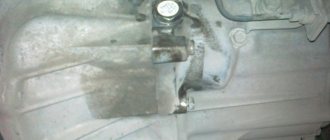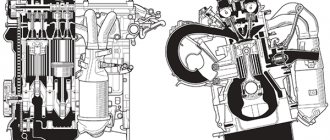Hydromechanical transmissions use a special fluid that degrades during operation, becoming saturated with wear particles from friction clutches and gears. Changing the automatic transmission oil on a Camry 50 ensures normal operation of the unit and is considered routine maintenance. The owner can partially drain the used material; full maintenance is carried out under specialized service conditions.
Replacement frequency
The manufacturer prescribes an inspection check of the oil in the gearbox crankcase every 2 years of operation or 40 thousand kilometers. The fluid should be replaced after 4 years (or 80 thousand kilometers) or if the technician detects cloudiness or metal shavings.
The manufacturer does not regulate the service life of the material. The condition of the oil is affected by operating conditions: in Russia it is recommended to drain the old fluid every 60 thousand km.
Signs indicating the need for early service:
- jerks or delays when switching steps up or down;
- detection of metal shavings on the probe;
- darkening of the liquid or appearance of a burnt odor.
How often does it need to be replaced?
In accordance with regulatory recommendations, mandatory oil control in the transmission system must occur at least once every two years.
The instructions for the Camry say that the oil level in the box is required to be checked at 40 and 80 thousand km.
Nothing has been written about any replacement. But this does not mean that there is no need to change the oil in the Camry automatic transmission.
Experienced technicians advise changing the lubricant in the box every 50 thousand if the replacement is partial, and every 70 - 80 thousand km if the oil is completely changed.
Also, fresh fluid is poured into the Camry gearbox if the old contents are very dirty and have a burning smell.
If you want to drive your Toyota Camry for a long time and without problems with the gearbox, then change the oil at least every 60 thousand km.
With constant aggressive (active) driving, and also if you often load the car to the maximum, it is recommended to check the lubricant level in the gearbox every 20 thousand miles.
A new oil filter element must be installed along with the oil.
The chips formed as a result of friction clog the filter element, and the pressure decreases. This is very dangerous because it can lead to overheating of the box even with updated transmission fluid. To get to the filter, you will have to perform manipulations to remove the Toyota Camry transmission pan.
Features of Toyota Camry 50
On Toyota Camry V50 cars with a 2.0 liter engine, assembled before restyling in 2014, a 4-speed automatic transmission was used, borrowed from the previous generation V 40. After modernization, the model code changed to V 55, and a 6-speed was installed box (similar to the unit used on 2.5 and 3.5 liter engines), which provided improved dynamic characteristics and reduced fuel consumption. All units are of the hydromechanical type and are maintained using the same methods.
Selecting automatic transmission oil
The automatic transmission crankcase contains a special transmission fluid that provides cooling of parts and removes wear products from contacting surfaces. The material passes through a paper filter, which ensures the separation of fine impurities.
As the element becomes clogged, the throughput of the element decreases and the cleaning efficiency decreases, so the part is changed along with the fluid during maintenance.
Original manufacturer
From the factory, the automatic transmission uses Toyota ATF Type WS fluid on a synthetic basis, which can withstand heating up to +130°C and does not solidify when the ambient temperature drops to -44°C. The material contains additives that reduce the wear rate of parts and ensure the removal of traces of corrosion. The oil is supplied packaged in tin cans of 4 and 1 liters (article numbers - 08886-02305 and 08886-80807, respectively), dealers purchase the material in 20-liter containers (manufacturer code - 08886-80803).
Transmission oil analogues
In addition to the original Toyota ATF Type WS material, you can use the following fluids:
- United ATF MV-66. It is characterized by increased kinematic viscosity at a temperature of +40°C. Loses fluidity when cooled to -46°C.
- Valvoline ATF. Crystallizes at -44°C and contains additional additives based on boron, phosphorus and zinc.
- Idemitsu ATF Type TLS-LV. Designed for ambient temperatures down to -57°C.
- Amsoil Signature Series Fuel-Efficient Synthetic ATF. Provides reduced gasoline consumption and does not freeze when cooled to -60°C.
How to distinguish an original from a fake
The main signs of a fake:
- the barcode field and the factory label on the back wall of the container are painted white instead of gray;
- the weld seam has a gap between the sheets, on the original can the joint is smooth with an overlap;
- the letters on the front part are light in color; the original uses gray paint;
- the handle is welded with a distortion, genuine products have neat welding;
- the cork after opening does not ensure the tightness of the container;
- The color of the fake is less saturated, the original is painted in a bright pink hue.
Checking the oil level before changing
The algorithm for checking the fluid level depends on the number of gears:
- The 4-speed unit has a tube leading into the engine compartment. Inside the line there is a steel dipstick with a plastic handle; the working element has liquid level marks in the hot and cold state. To check, you need to remove the rod, wipe it with a clean cloth, and then insert it back until it stops and pull it out again. On a cooled box and with the engine turned off, the oil should be at the Cold mark; on a hot unit (with the engine running), the level rises to the Hot mark.
- In the 6-stage unit, the level meter is screwed into the drain hole. The check is carried out on a lift after the engine and transmission have warmed up to operating temperature. At a normal level, after unscrewing the drain plug, the liquid drips in separate drops (with the engine running). Do not test with the engine stopped, as some of the oil will leak out of the crankcase.
What will you need for replacement?
A set of necessary parts and tools:
- working fluid (volume depends on the replacement method and type of gearbox);
- cardboard pan gasket (selected according to the automatic transmission model);
- new filter (design and part number depend on the modification of the unit);
- rubber ring of the filter element (supplied in the set or purchased separately);
- a sealing washer for the drain plug and a funnel with an extension tube (required in case of partial replacement);
- liquid for removing contaminants from pallet surfaces;
- clean rags;
- container for collecting spent solution (volume depends on the automatic transmission model);
- torque wrench with a set of interchangeable sockets for hex nuts and bolts.
Box operating modes
The automatic transmission model and control method (hydraulics, electronics) determine the set of its operating modes. Regardless of the type of transmission on the Camry, there are several main modes:
- P – parking mode. It should be chosen when parking for a long time. The gearbox is turned off, the shaft is blocked, and the drive wheels do not rotate.
Important: you cannot switch to this mode until it stops completely. Also, when stopping on uphill/downhill slopes, you should first tighten the handbrake, and only then put the box into parking mode.
- R – reverse gear. You can transfer to it from “parking” and “neutral” only after stopping the car.
- N – neutral mode. The box does not transmit torque to the wheels, but the shaft is not blocked and the drive axles can rotate. In this mode, the car can be towed over a short (important!) distance.
- 2 – movement is blocked in gears above 2. This gearbox mode is suitable for bad roads, frequent ascents and descents, since it uses engine braking.
- L – low gear. It is recommended to use it on steep slopes and off-road; in it, Toyota moves only in 1 transmission stage.
- D – main mode of the box, forward movement.
There may also be additional buttons on the lever - Overdrive (O/D), SNOW, PWR, MANU, NORM.
- NORM/PWR – switches transmission modes from normal to sports. In the second, the gear shift logic changes, the car becomes more dynamic, but consumes more fuel.
- SNOW – “winter” mode, in which the car starts from 2nd gear, making it easier to start driving on ice and snow.
- MANU button – found mainly on Toyota, similar to Snow.
- Overdrive – permission to use overdrive. When overdrive is active, the car is allowed to switch to the last gear (5, 6...); when overdrive is disabled, it is not. Many people recommend turning off overdrive in the city cycle to increase the service life of the box.
Instructions for a complete oil change
To fully replace the fluid in the Toyota Camry V50 automatic transmission, a special pumping station is required, which pumps the material through the working channels, washing out the deposited dirt. To carry out the work, 15-16 liters of oil will be required, which is then partially recycled.
The technique is not recommended for cars with mileages of more than 120 thousand km, since the valves of the hydraulic unit may become clogged with foreign particles.
Draining old fluid
Algorithm for removing old material:
- Connect the pressure and drain hoses of the device to the transmission housing.
- Fill the supply tank with 13-14 liters of liquid, then start the engine and turn on the external pump.
- Wait for the solution to pump through, visually assessing the condition and color of the liquid at the exit from the crankcase.
- After using up the material, turn off the equipment and turn off the engine.
Clearing space
Sequencing:
- Remove the protection elements for the lower part of the engine housings and gearbox.
- Wipe the outer part of the pan from dirt with a dry cloth.
- Unscrew the mounting bolts and carefully separate the reservoir from the crankcase.
- Pour out the remaining liquid in the pan (1.5-2 l), and then rinse the part with clean gasoline or kerosene.
- Remove the remaining sealing gasket from the mating surfaces.
Replacing the oil filter
To install a new oil filter you must:
- Unscrew the mounting bolts and pull the housing out of the mounting socket.
- Place the rubber ring on the pipe of the new filter and push the unit in until it stops.
- Tighten the fastening bolts.
Filling with new transmission oil
To refill the oil you need:
- Place the gasket on the edge of the pan, and then screw the assembly to the automatic transmission housing with even tightening of the bolts.
- On vehicles with a 4-speed transmission, insert a funnel into the dipstick hole. If you use a 6-speed unit, you will need to remove the left wheel and wheel arch liner, and then unscrew the filler plug.
- Fill the oil, monitoring the level using the dipstick (on old automatic transmissions) or until a leak begins through the control tube (on 6-speed units, work is carried out with the engine running).
How to replace it yourself?
Camry V40 2.4 and Camry 3.5 do not differ in transmission design, so they require the same maintenance. If you have certain skills, time and desire, you can change the oil in an automatic transmission yourself in a garage. However, it is worth warning that this is a rather labor-intensive procedure, and if you are afraid of doing it incorrectly, it is better to contact a specialized car service center where everything will be done according to the scheme. It is not possible to completely change the oil in a garage; this requires the use of specialized equipment. Many make do with partial replacement, which is quite affordable.
On a Toyota Camry, replacement should be accompanied not only by replacing the gasket and filter, but also by removing the pan. This is necessary in order to check the condition of the automatic transmission, remove dirt, and check for chips. Changing the gearbox oil on a Camry is partially quite simple. All you need to do is drain the old fluid and add new one.
Keep in mind that at home it will not be possible to drain more than half of the liquid. When the fluid in an automatic transmission on a Camry is partially changed, an average mass is formed, suitable for further use. However, if large metal shavings or a large amount of it are detected, it is necessary not only to completely update the consumables, but also to repair the box, as this is a symptom of a gear malfunction.
On a Camry, the number of partial replacements should be twice the number of full replacements, since only 2.0 liters of fluid are poured, and accordingly, it gets dirty faster.
Partial oil change
Algorithm for partial oil change in a 4-speed automatic transmission:
Place the car in a garage block with an inspection hole or on a mechanical lift. The supporting surface must ensure a horizontal position of the body.- Remove the protective screens, and then carefully unscrew the drain bolt.
- Place the container and wait 5-10 minutes to drain the maximum volume of liquid.
- Screw the plug into place (with the old washer), and then one by one unscrew the bolts securing the pan to the box housing. Some of the fasteners are located under the elements of the front subframe. To access the heads, use an angled spanner.
- Remove the tray and wash the outer and inner surfaces and magnets with gasoline or organic solvent, and then wipe with a dry cloth or lint-free rags.
- Unscrew the 3 filter mounting bolts and remove the element using downward force. After removal, 100-150 ml of liquid will flow out of the hole.
- Place the rubber sealing ring on the new filter (it is not recommended to use the old washer), and then tighten the 3 mounting bolts.
- Wipe the mating surface of the pan with a dry cloth and install a new seal. There is no need to apply a layer of sealant.
- Carefully align the bottom cover with the automatic transmission housing, and then tighten 2-3 fastening bolts (apply a locking agent to the threads).
- Tighten the remaining bolts and tighten the threaded connections to a torque of 40 N/m. If excessive force is applied, the gasket is destroyed, leading to leakage of the working fluid.
- Remove the drain plug, install a new ring, and then tighten the threads.
- Remove the dipstick and insert the tip of the funnel into the hole.
- Fill with fresh oil (the required volume of fluid is determined by the amount of drained material).
- Check the level, which should be at the Cold level marked on the dipstick rod. If the amount of solution is not enough, then it is necessary to add liquid.
- After changing the oil, start the engine, and then sequentially move the shift lever through all positions, pausing in each position for 3-4 seconds.
- Stop the engine and check the level. If the mark is below the Cold mark, then you need to add fluid.
- Reinstall the removed protective screens and make a test drive over a distance of 20-25 km, allowing the automatic transmission to warm up to operating temperature.
- Check the fluid level with the engine running. It should rise to the Hot mark.
In the Aisin 6-speed gearbox, instead of a dipstick, a plastic tube screwed into the drain hole is used to check the level.
To remove liquid, the measuring element is unscrewed. The level is checked on a warm unit with the engine running. When you unscrew the drain plug, single drops should come out of the hole. If there is no leak, then you need to add fluid through the hole on the side of the crankcase.
Checking the level
In the Toyota Camry V50, the automatic transmission lubrication level is checked by draining excess oil through an overflow flask located in the pan. Therefore, first add fresh ATF without starting the engine, and then adjust the level. We will fill the machine through the filler hole in the pan:
- Raise your Toyota Camry on a lift.
- Using a 10mm socket, unscrew the 2 bolts of the front left fender apron seal.
- If the car is hot, wait until the automatic transmission cools down to ⁓20℃.
- Unscrew the filler plug with a 24mm socket.
- Unscrew the overflow flask bolt with a 6 mm hexagon. If grease leaks, wait until it starts dripping. In this case, additional filling is not needed. Proceed to the warm-up phase.
- The flask must be tightened to a torque of 1.7 Nm, otherwise the level indicator will be incorrect. To check the tightness, insert a hexagon into the hole.
- Pour fluid using a syringe or other device into the automatic transmission filler hole until it begins to flow out of the flask. Screw both plugs with the old gaskets without tightening.
Now you need to warm up the oil, because as the temperature increases, it expands . To monitor the temperature, use a scanner or SST tool (09843-18040):
- Connect the scanner to the DLC3 diagnostic connector to monitor the oil temperature. It should not be higher than +40℃. Or connect pins 13 TC and 4 CG using SST to indicate codes.
- Start the engine to bleed the automatic transmission fluid.
- Start temperature detection mode. Switch the selector from position “P” to “D” and back with a delay of 6 s. Watch the gear indicator and move the lever between “D” and “N”. When the Toyota Camry enters the temperature detection mode, the “D” gear engaged indicator will light up for 2 seconds when the ATF heats up to the desired value.
- Turn off the scanner and disconnect the contacts. The temperature detection mode is maintained until the ignition is turned off.
Read
Full and partial oil change in automatic transmission Nissan Almera Classic
Set the oil level to normal:
- Raise the Toyota Camry.
- Remove the stopper of the overflow flask. Be careful, the liquid is hot!
- Wait until the excess drains out and the ATF begins to drip.
- If liquid does not flow out of the overflow flask, add lubricants until it flows out of the overflow flask.
After setting the level, tighten the control flask plug with a new gasket and a force of 40 Nm. The tightening torque of the filler hole is 49 Nm. Lower the Toyota Camry. Turn off the engine. Put the boot back in place.











